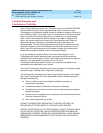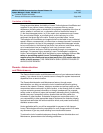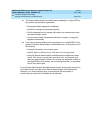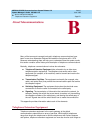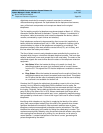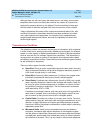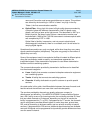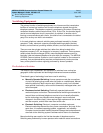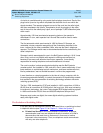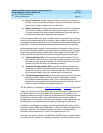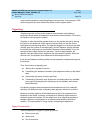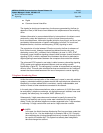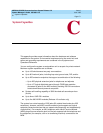
MERLIN LEGEND Communications System Release 5.0
System Manager’s Guide
555-650-118
Issue 1
June 1997
About Telecommunications
Page B-5Switching Equipment
B
Switching Equipment 2
The primary function of switching equipment is to interconnect the transmission
facilities at various key locations and route the telephone signals through the
telephone network. The telephone network is composed of a number of these key
centralized locations called central offices (COs). At the COs, the electrical signal
carried on one telephone circuit is connected, or switched, to another circuit,
forming a communications path; that is, the caller’s line is connected to the called
party’s line so they can hold a conversation.
In the early telephone network, switching was performed manually by human
operators. Today, electronic computer-controlled switching systems are fast,
flexible, and economical, providing reliable, efficient, and cost-effective service.
There are now also private switches that, rather than being located at the
telephone company’s CO, are located on a company’s premises. These systems,
called
private branch exchanges
(PBXs), were developed because most of a
business’ calls are between telephones on-site within the company. The MERLIN
LEGEND Communications System is a such a switch, located on the customer’s
premises, that provides advanced services and features and yet also provides
many of the special functions originally performed by human operators.
The Evolution of Switches 2
The method, type, capabilities, and capacities of switches have evolved as
geographic areas expanded and technological advances became available.
Three basic types of technology have been used in switching:
■ Manually-Operated Switching. Human operators made the connections
of circuits by placing plug-ended wires into jacks on a switchboard. Manual
switching was slow, labor-intensive and, therefore, costly, but it afforded
some special functionality: calls could be forwarded, messages taken, and
calls interrupted.
■ Electromechanical Switching. Electrically operated devices with
mechanical parts and motion. Electromechanical switching automated the
manual labor and allowed telephone service to be universally affordable,
but the technology was inflexible since changes in service required
changes in the device itself. It also required high maintenance due to wear
and tear on parts, and did little more than switch calls.
■ Electronic Switching. Electronic, computer-controlled equipment.
Electronic switching reduced the size, power consumption, and cost. At the
same time, it increased operating speeds, ruggedness, and reliability.
Computer control provides flexibility because changes and enhancements
are made to the switching system’s software rather than to the hardware.
Manual switching was used for the first few decades of telephone service.
Switching was performed by human operators who made the actual connections



